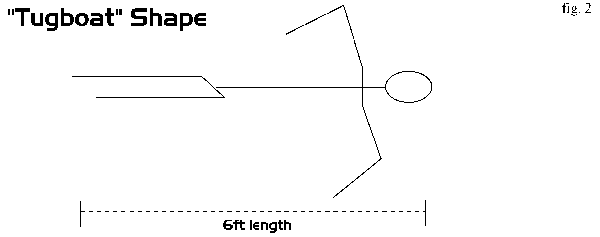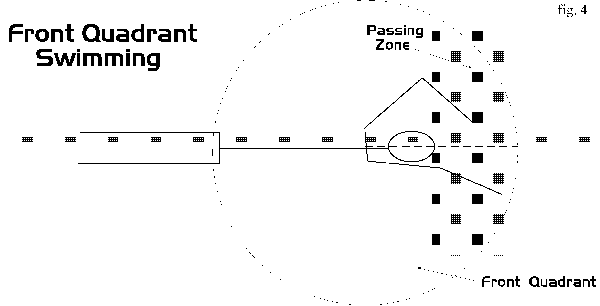Swimming in Circles
Have you ever taken a few minutes to watch the very best swimmers create their art? I know you've watched them race and marveled at their speed and power, but have you ever taken the time to sit for awhile and absorb more information about exactly how they do what they do? An ideal way to do this is to watch the very best swimmers work out - particularly, watch them swimming EZ and watch them doing drills (yes, elite swimmers swim EZ and do lots of drills - almost assuredly, more than you do - with the single focus in both activities being the development and application of absolutely perfect technique). Better yet, watch two or three elite swimmers working out together.
Recently, some of us (Masters Coaches) were privileged to watch several world class freestylers (including Olympic Gold Medalist Jenny Thompson) working out together. We had the opportunity to watch (and review on video tape) and compare several different world-class swimming styles.
While each swimmer had his or her own distinct method of swimming freestyle there were several points of comparison where there was complete agreement across the field - swimming mainly on the sides, rapid but fluid transitions from side to side, high elbow / low hand recovery, long distance per stroke, long body positions and Front Quadrant Swimming.
"What was that last one, Coach? Front what?"
Allow me to explain. Actually the last two are closely related - long body positions and FQS (yeah, another acronym). Let me start with long body positions. Back in the 1840's there was a guy named W. Froude who showed that the shape of a vessel in the water, and the ratios of length, width and depth, determined the amount of wave drag (80%+ of total drag) that vessel would have at any given speed. I won't go into the details and math but, suffice it to say that this concept is responsible for racing boats of all kinds being generally long and sleek looking.
The implication for swimming is that drag and the power required to overcome it are significantly reduced when the body is made as long as possible and kept that way for as long as possible during each stroke cycle. Or, said another way, drag tends to increase as body length decreases.
Try this experiment. Push off the wall as hard as possible with your hands at your sides and see how far you can glide. Now push off the wall with the same force but use a fully streamlined hand-over-hand, wrist-over-wrist, head squeezed firmly between your arms position and glide as far as possible. If you do not glide a lot (25-50%) farther have your coach check your streamline position.
"So, how does this relate to FQS?" I'm getting to that. Be patient, will ya?
Imagine, if you will, a sailing event where two evenly matched racing boats (one red and one blue) and crews are pitted against one another. Also imagine that once every second the blue boat morphs into a tugboat shape for half a second then morphs back to racing boat shape. You know intuitively to bet on the red boat which keeps its long sleek shape.
Let's take the average 6ft tall person who, when stretched to full streamline position, becomes an 8'6" to 9'0" long vessel in the water. Lets put him in a blue suit and have him swim along at a nice moderate pace being sure that he is getting into a fully streamlined, side-lying position on each stroke. We'll call this the "racing boat" shape.

Now, say he begins his recovery and his stroke at the same time so that his recovering arm and pulling arm are passing the shoulders at about the same time - we'll call this the "tug boat" shape.

Now the guy in the next lane (same height, same racing boat shape, red suit) has figured out a way to keep from morphing from the racing boat shape into the tug boat shape and back. Instead of starting his recovery and pull together, he begins and nearly completes his recovery before he begins his arm stroke (figs. #3 & #4).

In this way he maintains his streamlined side-lying position, and nearly all of it's length, for nearly the entire stroke cycle. Then there is a rapid transition of the hips from one side to the other as the recovering hand enters the water and the stroking arm begins to do it's thing.
This is called Front Quadrant Swimming. The large circle in Figure #4 below shows that the recovering hand of the fellow in the red suit is about to enter the water while his stroking hand is still in the First or Front Quadrant. Another way of thinking about this is to be aware of where your hands "pass" each other as your recovering hand is moving forward to enter the water and your working or stroking hand is moving in the opposite direction. Your "passing zone" should be at, or forward of, your head. Just as the red racing boat attracted your wagers, the guy in the red suit is deserving of your attention.

Keeping an arm outstretched in front of the body at all, or nearly all times during the stroke allows the average length of the vessel in the water to stay long, thus reducing wave drag dramatically. There are a variety of other mechanical considerations, too numerous to mention here, that also help to explain why, when you look at the ranks of elite freestyle swimmers everywhere you will find Front Quadrant Swimming taking place.
One of my basic philosophies in coaching (hell, in life in general) is this: If the very best athletes and coaches all, or nearly all, agree on a topic then the chances are that they are on the right track and if you want to be truly successful, then you better get on that track too. If they all disagree on a topic then perhaps that is an area that allows for more latitude based on personal preference - like suit color.
This Article first appeared in Schwimmvergnugen, the monthly newsletter of H2Ouston Swims.
Emmett Hines is Director and Head Coach of H2Ouston Swims. He has coached competitive Masters swimming in Houston since 1982, holds an ASCA Level 5 Coach Certification, was selected as United States Masters Swimming
Categories:
- Coaches Only
SIGN UP FOR UPDATES FROM USMS















